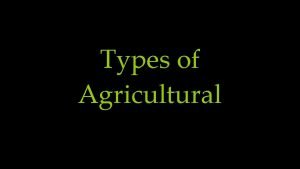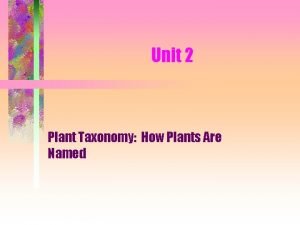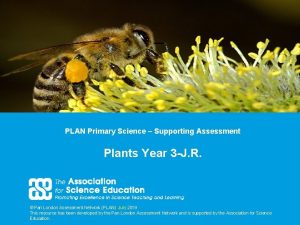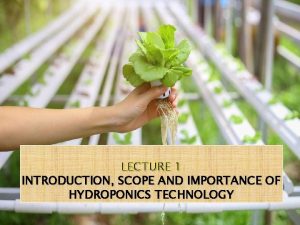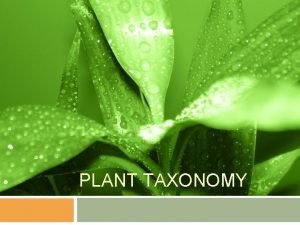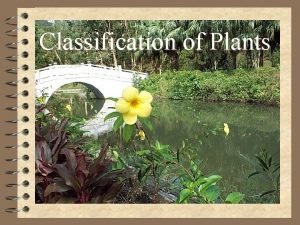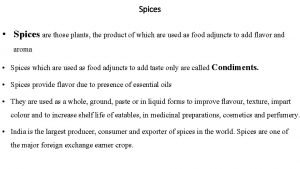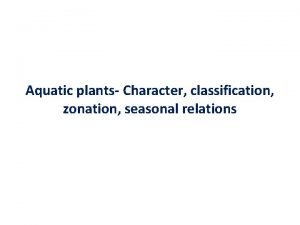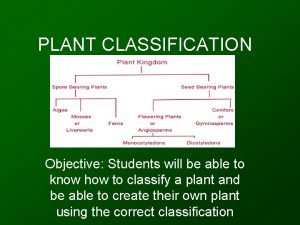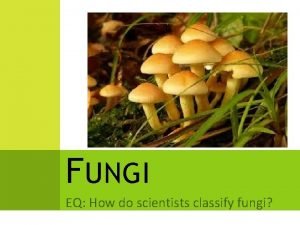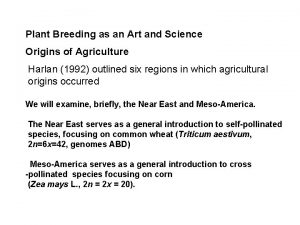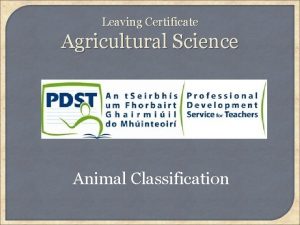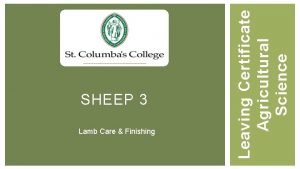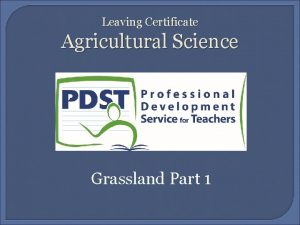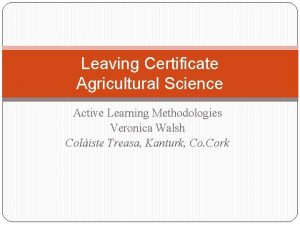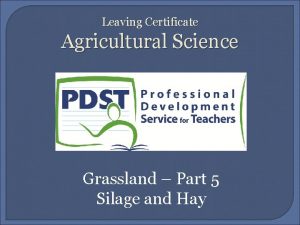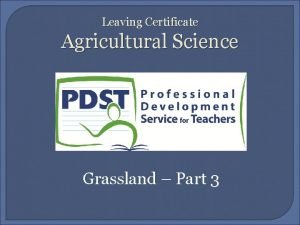Leaving Certificate Agricultural Science Plant Classification Naming Plants































- Slides: 31

Leaving Certificate Agricultural Science Plant Classification

Naming Plants and Animals � Species are named using a system developed in 1750 in Sweden by Linnaeus. � Each species is given two names. � The first is the genus name. � Each genus contains a number of related species. � For example Buttercups belong to the genus Rannunculus. � Different types of buttercup then have a different species name e. g. Creeping Buttercup is Rannunculus repens while the common buttercup is called Rannunculus flutans. � The genus and species are always written in Italics but when hand - written they should be underlined. � Also the genus should have a CAPITAL letter and the species should have a small letter.


Mosses - Bryophyta � Mosses are non-vascular plants -- they cannot transport fluids through their bodies. � Instead, they must rely on surrounding moisture to do this job for them. � Though small in stature, mosses are very important members of our ecosystem. � They lay the foundations for other plant growth, prevent erosion, and contribute to the lush green appearance of many forested areas.

Mosses

The Fern - Pteridophyta � Ferns have a vascular system to transport fluids through their bodies but like the mosses, they reproduce from spores rather than seeds. � The main phylum, the Ferns (Pteridophyta) includes around 12, 000 species. � Three other phyla are included as fern allies: the Horsetails, Club Mosses and Whisk Ferns � Ferns also have a gametophyte and sporophyte stage, but the gametophyte stage is much reduced.


Conifers - Gymnosperms The gymnosperms add the next level of complexity to plant evolution: they reproduce from seeds instead of spores. � The seeds, however, are "naked" (Greek: gummnos) -not covered by an ovary. � Usually, the seed is produced inside a cone-like structure such as a pine cone hence the name "conifer. " � Some conifers, such as the Yew and Ginko, produce their seeds inside a berry-like structure. � Conifers are fairly easy to identify: In addition to the aforementioned cones, these trees and shrubs typically have needle-like, scale-like or awl-like leaves. � And they never have flowers. �


Angiosperms � They are plants that produce flowers. produce seeds, enclosed within a fruit or nut. � Angiosperms include all broadleaf trees, grasses, roses, vegetables etc. � They are important agricultural crops too!

Angiosperms: Monocots & Dicots � Seed bearing plants of the Order Angiosperm are further classified into two group called Monocotyledons and Dicotyledons. � Angiosperms in the class Dicotyledoneae grow two seed-leaves (cotyledons). � In addition, foliage leaves typically have a single, branching, main vein originating at the base of the leaf blade, or three or more main veins that diverge from the base. � The vast majority of plants are Dicots. Most trees, shrubs, vines, and flowers belong to this group of around 200, 000 species. � Most fruits, vegetables and legumes come from this class. � These groups are divided into FAMILIES.

Angiosperms - Monocots & Dicots

Angiosperms - Monocots & Dicots

Cruciferae � This family include wallflowers and many Brassica vegetables like Cabbage, Brussels sprouts, Cauliflower, Turnips, Mustard plants etc. � They are classified by floral parts, arranged in fours. (4 sepals, petals & stamen). � Their flowers are in the shape of a cross, hence the name Cruciferae.


Rosacae � Also � It known as the Rose Family. includes apple, pear, peach, plum, cherry, apricot, almond, nectarine, prune, raspberry, blackberry, dewberry and the strawberry. � They are characterised by five sepals and petals and numerous carpels and stamen.


Leguminosae � Also called the pea family, they are characterised by five petals (One large, two small and two even smaller “wings”). � A common feature in the family is the presence of root nodules containing bacteria of the genus Rhizobium. � These bacteria convert atmospheric N, which cannot be used by the plants, into nitrate (NO 3 -), a form that can be used. � This family is the second most economically important family after grasses and has over 18, 000 species. � Important species include peas, clover, vetch as well as gorse, a pest in some farms


Liliaceae � This is a monocot family, whose members include onions, garlic, lilies, tulips, bluebells and hyacinths. � This family is characterised be fused petals and sepals. � Their floral parts are in multiples of three – six sepals, six petals, six stamen and three carpels.


Gramineae � This is the grass family, and includes all grass species as well as cereals such as wheat, oats, barley maize and rice (and bamboo). � Grass species have flower structures based on the use of wind pollination. � Therefore they do not contain bright, colourful petals to attract insects, as this is not required. � Grass plants produce high levels of pollen to increase its chances of reproduction – this high level of pollen cause hay fever. � Grass flowers are said to be hermaphrodite – they contain both male and female parts. � These are formed on an inflorescence.


Compositae � This is the largest family of plants (NB) and includes daisies, dandelions, thistles, lettuce and sunflowers. � The family is called Compositae because each flower is actually a composite of many “florets”. � If you look at a daisy, you will find to different types of floret (the white “ray” floret and the yellow “disc” floret.


Umbelliferae � Members of this family have a distinctive florescence (collection of flowers) shaped like an umbrella. � Each of the flowers are small but contain five sepals, stamen and petals and two carpels. � Members of this family include parsley, dill, celery, carrots and parsnips. � Giant hogweeds and cow parsnip (parsley) are also weeds belonging to this family.


Other Families Raunculaceae � The buttercup family. Solanaceae � This family contains potatoes, tomatoes, tobacco and the “deadly nightshade”. Polygonaceae � Rhubarb family – rhubarb, dock and buckwheat.



 History syllabus leaving cert
History syllabus leaving cert Primary leaving certificate
Primary leaving certificate Leaving certificate
Leaving certificate Whittlesey classification
Whittlesey classification Derwent whittlesey agricultural regions
Derwent whittlesey agricultural regions My favourite subject is science because
My favourite subject is science because Vascular plants vs nonvascular plants
Vascular plants vs nonvascular plants Vascular plants vs nonvascular plants
Vascular plants vs nonvascular plants Characteristics of non-flowering plants
Characteristics of non-flowering plants Photosynthesis equation
Photosynthesis equation Importance of scientific name
Importance of scientific name Sunflower classification
Sunflower classification The science of naming and classifying organisms
The science of naming and classifying organisms Unit 2 plant taxonomy how plants are named
Unit 2 plant taxonomy how plants are named Cs.princeton.edu
Cs.princeton.edu Certificate iv in clinical classification nsw
Certificate iv in clinical classification nsw Define plant breeding
Define plant breeding Plant breeding for disease resistance
Plant breeding for disease resistance Plant introduction in plant breeding
Plant introduction in plant breeding Tronsmo plant pathology and plant diseases download
Tronsmo plant pathology and plant diseases download Tronsmo plant pathology and plant diseases download
Tronsmo plant pathology and plant diseases download Tronsmo plant pathology and plant diseases download
Tronsmo plant pathology and plant diseases download Plants year 3 science
Plants year 3 science Scope of hydroponics
Scope of hydroponics Classification of plants
Classification of plants Order of classification
Order of classification Classify non flowering plants
Classify non flowering plants Difference between condiments and spices
Difference between condiments and spices Aquatic plants can be classified into
Aquatic plants can be classified into Classification of plants
Classification of plants F
F Why is plant breeding considered an art and a science
Why is plant breeding considered an art and a science



